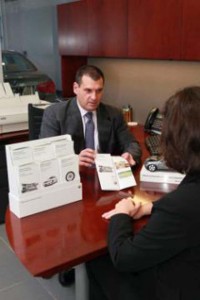When she began looking for a new car, Chris Anderson had her heart set on a midsize Ford sedan. But in the end, she wound up buying from the Detroit maker’s cross-town rival General Motors. It wasn’t that she liked her new car better. It was the dealer she liked – or more precisely, the Ford dealer she didn’t want to buy from.
And the Detroit saleswoman is not alone. What happens when a customer walks into the showroom can have a big impact on what they buy – or where they buy – says Fran O’Hagan, an automotive analyst whose annual Pied Piper Prospect Satisfaction Index is aimed at measuring which dealers and brands do the best job in treating prospective car shoppers. And this year, the study found Mercedes-Benz repeating as the industry leader.
The Pied Piper study relies on so-called “mystery shoppers” who go through the car buying process at thousands of U.S. showrooms each year subtly notating how well salespeople handle such basics as providing buyers with a vehicle walk-around, brochures and test drives, things O’Hagan explains “correlate highly with whether a customer buys.”
Not surprisingly, he adds, manufacturers who have carefully defined the sales process and who have convinced dealers to consistently adopt those practices tend to have a significantly higher closing rate – the percentage of customers who walk into a showroom who actually drive off with a new vehicle. For the industry, as a whole, the figure is a mere 15 to 20%.
The good news, contends California-based O’Hagan, is that, on the whole, “dealerships all over the U.S. do a better job selling cars today” than they did when the first Pied Piper Satisfaction Index, or PPSI, was released in 2007. That said, there’s a big gap between the best and worst brands and showrooms and, the analyst cautions, there have actually been some setbacks in recent years.
O’Hagan revised the study this year but found those brands that have traditional done well continued to lead the pack, while marques that previously fell to the bottom continued to lag. Mercedes-Benz came in at the top with a score of 113, followed by Infiniti at 110, Lexus at 106, and Audi and GMC tied at 104.
Mercedes, O’Hagan notes, has been the industry leader for four years running – after long being a mid-pack brand. That reflects a conscious corporate decision to improve the way the German maker’s U.S. dealers treated customers – and it was reflected in not only improve PPSI scores but improved closing rates.
“The way your salespeople sell is relatively simple to change,” the analyst suggests, “and the payoff is more sales.”
So, perhaps, it’s not surprising that some of the market’s poorer-performing brands lag in the dealer survey, Scion at the bottom with a score of 88, Mitsubishi at 89, and Mazda and Chrysler following with scores tied at 94. It’s perhaps less of a surprise that Lincoln, rounding out the bottom five with a score of 96, has said it wants to transform the sales experience at its showrooms as it rebuilds the brand.
Part of the challenge, however, is to not just lay out a better sales process on paper, O’Hagan stresses, but actually to get dealers to buy in – consistently.
“There are some Scion and Mitsubishi dealers who perform brilliantly,” he explains, but they don’t do so consistently.”
Some of the things that distinguish a good dealer from a bad appear unexpectedly simple. It starts with the way shoppers are greeted when they walk into a showroom. Pied Piper’s mystery shoppers are told to record whether they are given brochures and offered test drives. Putting a shopper behind the wheel, O’Hagan notes, is one of the most effective ways to clinch a deal. Yet, one of the biggest surprises is how often sales people fail to ask the most basic question: “Are you ready to buy?”
While the PPSI suggests the car buying process has, on the whole, improved, there were some setbacks and weak points. O’Hagan says the biggest problem is the Internet. About 80% of U.S. car shoppers now begin the buying process online, he notes. But there’s a big difference between the way good and bad dealers respond. Among those in the top quartile of the 2013 survey, 93% will respond to a customer’s online query within 24 hours. Among dealers in the bottom quartile, only 16% respond.
“The internet side of the business is the wild west,” O’Hagan says. “There’s a huge difference between dealers that do a good job and a bad job selling online,” and in the long run, that can make the difference between not only success or failure for a showroom but for the brand it represents.

